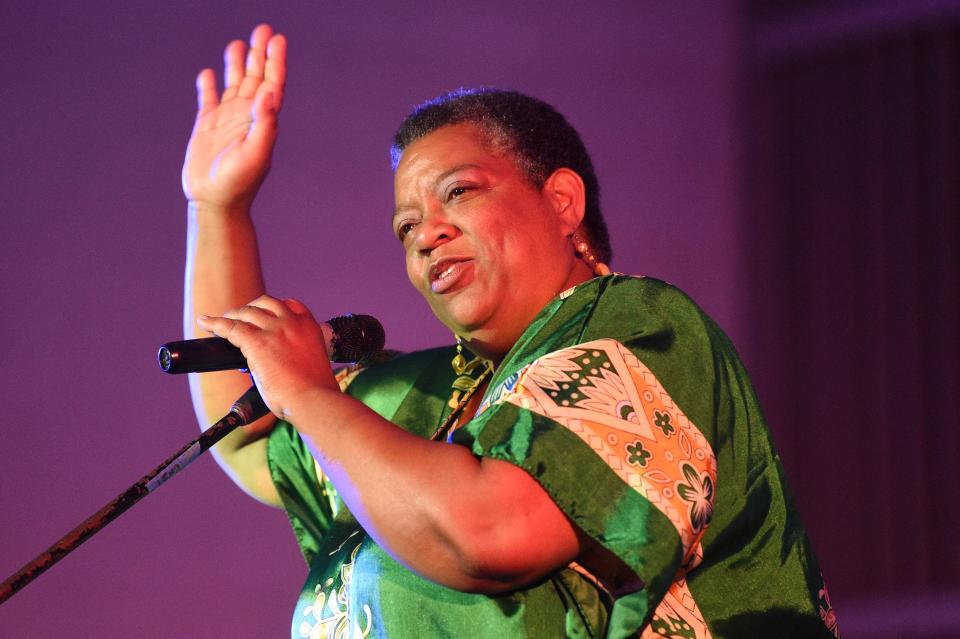'We tell the story because the story did not need to be forgotten'
The crowd applauded for a story that was — for some of them — their story.
Professional storyteller Sheila Arnold told the story of the first Black students to attend Oak Ridge Schools and the people who helped them during the opening night of the Flatwater Tales Storytelling Festival at the Historic Grove Theater. Some of those 85 Black students who were the first to attend Robertsville Junior High and Oak Ridge High School in 1955 sat near the front of the stage as Arnold talked about their achievements and the need for the world to remember them. She titled the story, "The Secret City's Secret City: Scarboro."
"Some secrets are not meant to be kept. Some secrets need the light of day to expose them," she said near the beginning of her story, regarding the Black community of Scarboro.
Scarboro, she said, was kept to the side during the segregation era, away from the white residents. However, she said, Scarboro got attention during the time of desegregation, as people from that neighborhood started going to the all-white Oak Ridge Schools. Similarly, she spoke of the history of desegregation as something about which people kept quiet, but now the world needs to hear.

"We tell the story because the story did not need to be forgotten," she said.
Eighty-five Black students became the first to enter previously-all white schools in Oak Ridge in 1955. Oak Ridge Schools were still at that time under the control of the federal government. Those Black students, now senior adults, are referred to as the "Scarboro 85" after the neighborhood where they lived.
Arnold pointed out that the general public doesn't know as much about the" Scarboro 85" as the "Clinton 12," who desegregated Clinton High School in 1956, or the "Little Rock Nine," whose integration of Central High School in Arkansas came about in 1957.
"I thought it went fantastic," "Scarboro 85" member L.C. "Larry" Gipson told The Oak Ridger following Arnold's "story" of the integration of Oak Ridge Schools. "She made a good story about the trials and tribulations of the students that integrated Oak Ridge High School in 1955."
Arnold said Gipson had served as a source of information for her.
Gipson said it's good that people are learning about what he and others went through.
"It's been a secret for over 65 years," he said regarding how the "Scarboro 85" story has remained obscure.
'Scratched and clawed and fought'
Arnold celebrated the heroism, not just of the "Scarboro 85" students, but also of others who helped them — such as Scarboro School Principal Arizona Officer, whom Arnold compared to the fictional superhero "Iron Man." She celebrated both Officer's work during integration and in setting up the Scarboro School before that, ensuring her students would have the best teachers.
Arnold said that Officer "scratched and clawed and fought" for the 85 students who integrated Oak Ridge Schools.
She compared then-Oak Ridge High School Principal Tom Dunigan, the father of current Oak Ridge resident Pat Postma, to a sheriff, keeping order — even if it meant finding a burning cross on his front lawn.
She said Dunigan was successful and "no trouble happened" to the students, unlike in other school desegregation efforts like Clinton and Little Rock. Two years after the integration, Clinton High School was bombed.
"Just because there was no violence does not mean there was no trauma," Arnold told the newspaper in an interview about the experiences of the "Scarboro 85." She said they were heading to Oak Ridge Schools amid racial tensions in the country, such as the murder of Emmett Till in Mississippi that same year.
'Scarboro itself'
Arnold said the story was "bigger than the 'Scarboro 85.' It was Scarboro itself."
Both on stage and in an interview, the storyteller described a moment during her research that stood out to her. She described going to the Oak Ridge History Museum with city historian D. Ray Smith, who writes a weekly "Historically Speaking" column for The Oak Ridger. The museum has an image of a panoramic view of early Oak Ridge. Viewing that image, Arnold said, it struck her that the historically Black areas were hidden behind trees. She said the Black areas being hidden served so that other residents did "not have to consider the people who helped build this town"
She added that Scarboro's history, like Scarboro, was similarly "pushed off to the side." Yet, she said, the Scarboro residents "built an amazing community."
Memorial needed
Arnold told the audience about visiting the Peace Pavilion at A.K. Bissell Park in Oak Ridge and ringing the International Friendship Bell.
"I could feel the reverberations of that bell," she said.
Similarly, Arnold said the "Scarboro 85" need a memorial to "reverberate" their story.
"I don't want this to be a presentation that lets people feel, but not do anything about it," Arnold said during the interview. She said she she hoped to inspire the creation of such a memorial.
"We do not need to pick and choose in history what we remember and what we forget."
Arnold has been performing since age eight and has been a professional master storyteller since 2003. She developed her story about Scarboro during a six-week residency at MacDowell Artist Colony in New Hampshire. Flatwater Tales commissioned Arnold to write and tell the story of the "Scarboro 85," according to advance publicity about the event. You can read more about the Storytelling Festival in Friday's edition.
Ben Pounds is a staff reporter for The Oak Ridger. Call him at (865) 441-2317, email him at bpounds@oakridger.com and follow him on Twitter @Bpoundsjournal.
This article originally appeared on Oakridger: Telling the story of Oak Ridge schools' desegregation

